By Ira Levin
Directed by Matthew Warchus
At the Noel Coward Theatre
When Deathtrap took to Broadway in the late 1970s, it became an instant smash-hit, running for four years with nearly two thousand performances. There is no denying that Levin’s script is incredibly well-written; its characters are keenly observed and it manages a plethora of plot-twists without becoming overly complex or predictable.
Reviewing thrillers is often burdensome for even the most accomplished journalists because it is difficult to adequately critique them without spoiling its potential for new audiences. However, I think it’s safe to say that the plot revolves around burnt-out playwright and professor, Sidney Bruhl, who hasn’t written a play for eighteen years, and his relationship with a student named Clifford (Jonathan Groff) who sends him the draft of a thriller entitled Deathtrap which has all the makings of a surefire hit. Naturally it is not long before bitterness and jealousy begin to cloud Bruhl’s judgement.
Simon Russell Beale is effortlessly competent in his portrayal of Bruhl. Those who saw him in Tom Stoppard’s Jumpers at the National and Piccadilly Theatres in 2004 will know what to expect: vibrant, literary speeches delivered with all the detached cynicism of an academic past his prime. He plays the part well but not outstandingly given his almost untouchable acting credentials. Actually it is Clare Skinner’s performance as his neurasthenic wife, Myra, which really stands out. Her frenetic speech and pacing brings an element of credibility to the play, which would otherwise be all but lost (due in no small part to the annoying ‘climactic’ music which is heard during the most intense scenes). Helga was well-played by Estelle Parsons – necessarily obvious and irritating – as showbiz psychics most often are, although it was a shame to see what should be her stand-out performance in the final scene being somewhat rushed over.
Watching this production one has the feeling that a great script has been slightly cheapened by Matthew Warchus’ direction through its over-reliance on laughs and pyrotechnics. The ‘play within a play’ concept works well if it’s done properly; this production made it more obvious than was really necessary.
Having said that, there is much to be gleaned from this production of Deathtrap. Rob Howell’s set design is truly terrific. The staggered geometry of the one room in which all the action takes place is incredibly well thought-out and with Bruhl’s festoonery of weapons all menacingly placed above the action, adding tension to the piece. Similarly, the scene in Act I where Bruhl asks Clifford to try on his antique Houdini handcuffs is especially suspenseful and there are a few others which compensate for the cheap thrills. Most of the murder scenes are shocking enough to be effective and elicit a few jumps from the audience.
On the whole, Deathtrap is definitely worth seeing and in fairness, it’s a comedy murder-mystery so it isn’t going to be easy keeping all of the audience simultaneously amused and afraid. Just make sure you take friends, get cheap seats and hit the bar beforehand.





